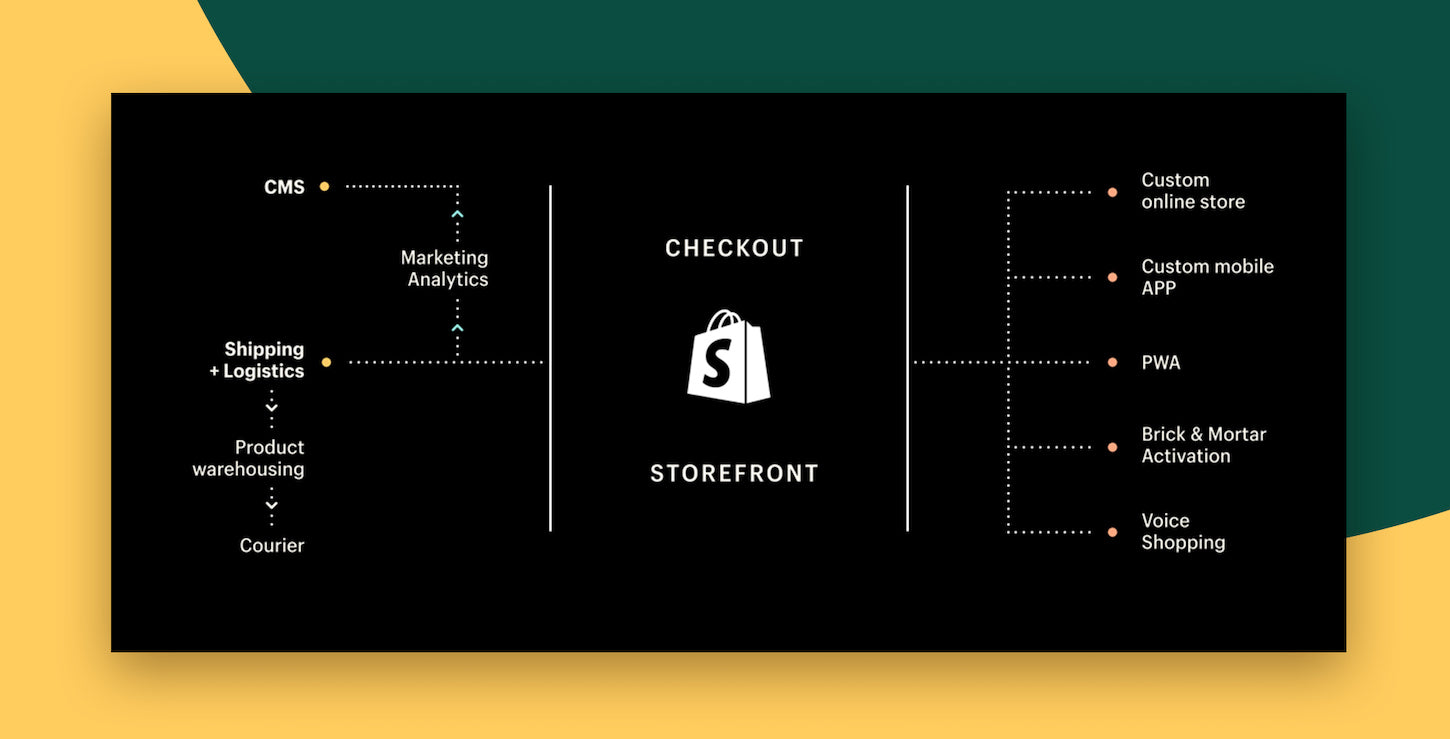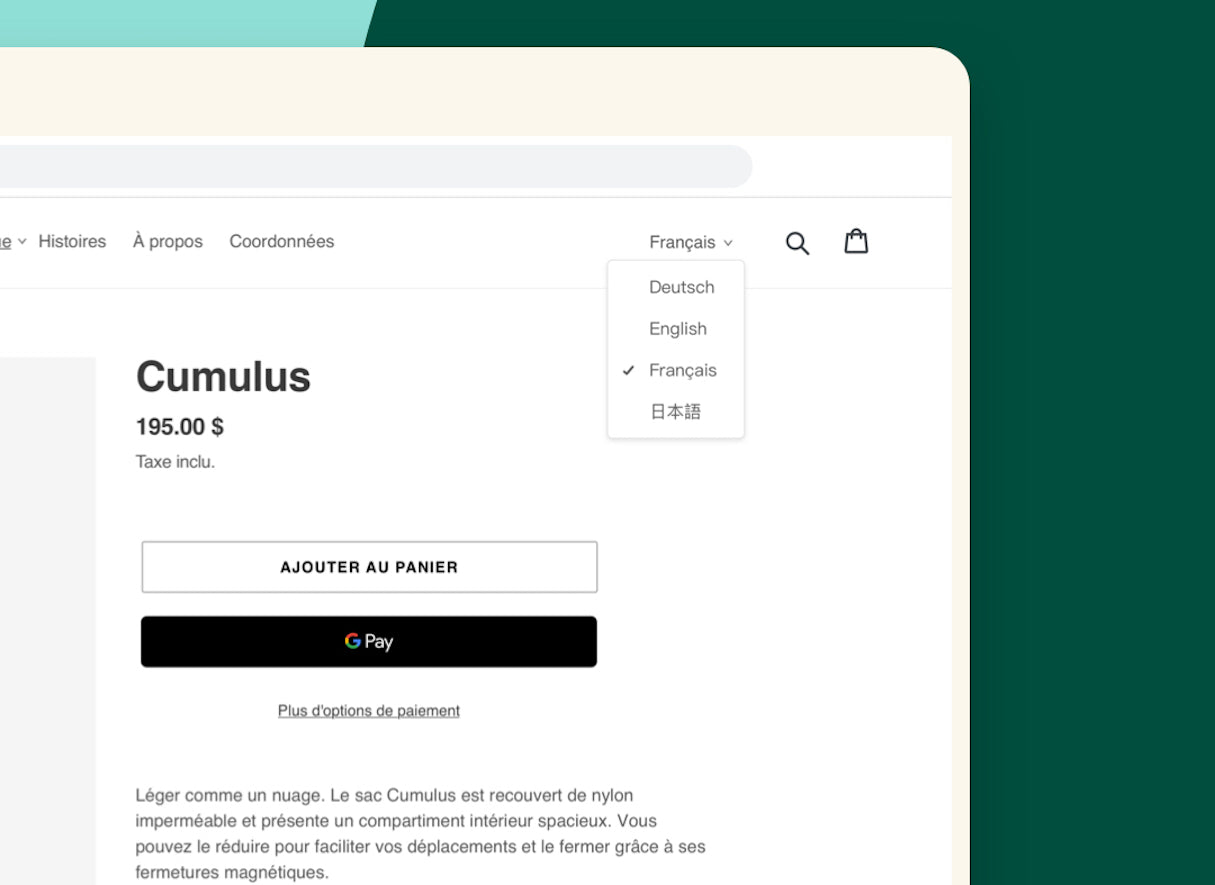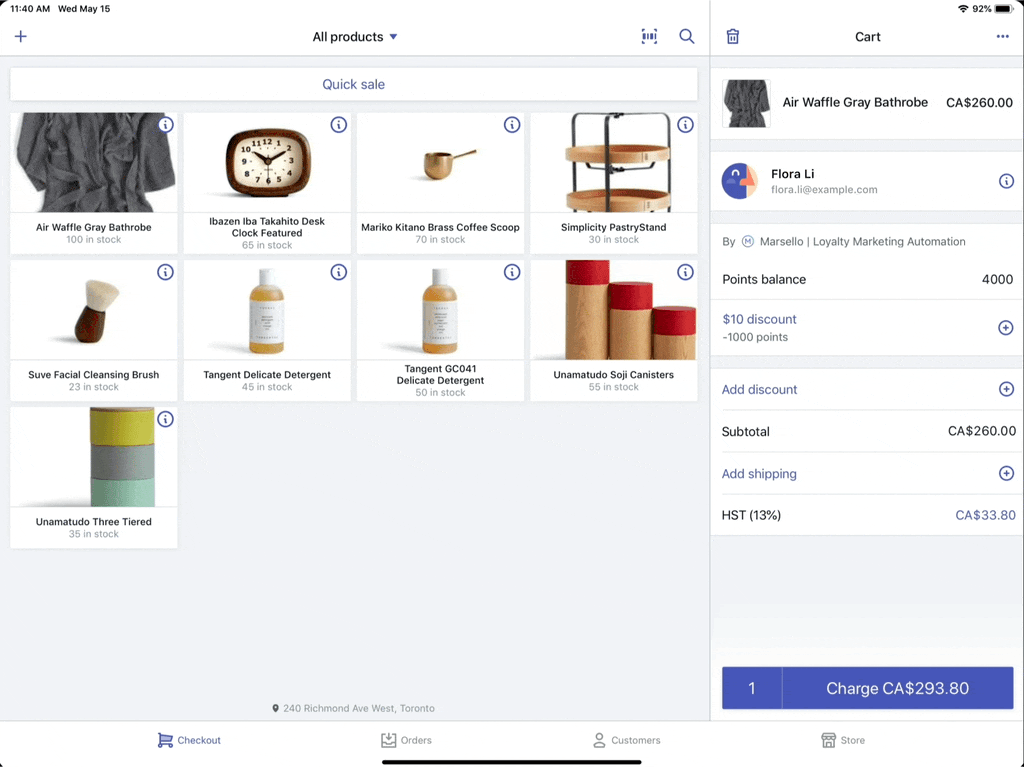At this year’s Shopify Unite, Shopify leadership took the stage to talk about the future of commerce, and to give the partner and developer community a look at our product roadmaps.
The opportunity ahead is bright and full of possibilities. To help you make sense of them all, we’ve put together a high level view of every product update and launch announced from the Shopify Unite mainstage.
Table of contents
- Online Store: Core
- Online Store: Advanced
- Shopify POS
- Backoffice
- Shopify Plus
- Developer products
- Shopify Fulfillment Network
1. Online Store: Core
The online store is the heart of any merchant experience: it’s often the center of their multi-channel strategy and where their entrepreneurial journey begins.
That means it’s critical that merchants can offer an online store experience that attracts buyers and showcases their products in the best possible light.
Today, we’re announcing a major upgrade to the online store, giving you access to more powerful tools to help merchants express their brand and delight their customers.
A new online store design experience

July 15, 2020: Online store design experience developer preview ending
We are closing this phase of the online store design experience developer preview as we work towards the next iteration. If you are currently using the developer preview shop to build a new sections-compatible app or theme, you will need to back up your work before the developer preview ends.
Learn moreOur new online store design experience will make it easier for merchants to create and customize their storefronts without writing a single line of code. We’ll be introducing a new feature set that will allow you to focus less on guiding your clients through the basics of store editing, and more on providing those highly valuable skills and services needed to take a merchant’s business to the next level.
Here’s what’s new:
- Sections on every page: When we first introduced Sections, it allowed merchants the ability to easily add or move content on their homepage with just a few clicks. We’ll now introduce sections-based editing to any page of a merchant’s online store, giving them ultimate flexibility to create and customize pages to their needs.
- Master pages: This new feature will allow merchants to define the content that will appear on multiple pages, and apply changes to all pages under a specific page type, simply by editing the master page.
- Content portability: Content will no longer be stored in themes. Merchants will no longer have to duplicate their themes to make changes to their store, and will be able to more easily switch between themes without transferring their content manually.
- Draft changes: We’re introducing a new safe place for merchants to draft changes to their online store, prior to publishing. They’ll be able to change aesthetics and content on existing and new online store pages, and publish when they’re ready.
- Online store editor: All of these changes are wrapped up into a new user interface that makes navigating store creation more intuitive, and makes it easier to edit all your store components in one place.
For Shopify Partners, these updates will also unlock new app sections, giving merchants the ability to add apps to their storefront, just like they would any other section. We’ll be releasing a new online store app extension for partners to facilitate this. Be sure to subscribe to the Web Design and Development Blog for more information leading up to these exciting launches.
Shopify Partners can learn more by visiting our technical documentation. Developers can also start exploring these changes with the Sections API in developer preview. You can find everything you need to get started in our changelog. Closer to merchant availability, we’ll also share the new UI.
[Coming Soon] Checkout app extensions: Subscriptions
We work hard to continuously improve the experience for partners, merchants, and their customers. That’s why we’re pleased to announce that coming soon, Shopify Partners will be able to access our first ever checkout app extension, which focuses on improving the purchase flow for subscriptions.
Buyers will no longer be routed outside of Shopify’s checkout to complete their transactions. Developers will be able to integrate their subscription apps into the checkout experience, surface their app’s information into Shopify’s checkout, and give merchants the ability to process transactions for subscription goods and services within one seamless checkout experience.
The checkout app extension for subscriptions will be available later this year. Keep up to date on all Shopify platform information by subscribing to our monthly product email for partners, What’s New with Shopify.
Build better brands with Video and 3D

Winning the attention of today’s buyers has a lot to do with weaving a powerful brand story—in fact, based on the current usage of Shopify AR, we know that interacting with a product in augmented reality significantly improves conversion rates. That’s why we’re investing in more powerful and robust product browsing experiences that drive higher engagement and better conversion.
Later this year, the Video and 3D update to the product section of the Shopify Admin will become available to all merchants, and will natively support video and 3D model assets for products. Storage, delivery, and access through both the Shopify Admin API and Storefront API will become available. This also includes:
- Storage: Merchants will be able to manage media from a single location, with Shopify hosted video and 3D assets sharing the same workflow as images.
- Delivery: Merchants using one of our 10 basic themes will be able to display their video or 3D assets on their storefront through the Shopify video player and Shopify AR.
This update also means that there is a new Shopify player for video and viewer for Shopify AR, as well as additions to Liquid to consider.
We’re also introducing a new area for partner contribution: editor applications. From image and video editors, to new ways to produce content for the web and augmented reality, developers will be able to build apps that allow merchants to create, edit, and refine media in the admin via a new, soon to be released, app extension.
With Video and 3D access, partners can now build richer and higher converting buyer experiences for their merchants. Read through our 3D model creation documentation to get started.
Introducing the Media APIs
Shopify Developers can now associate videos and 3D model assets with a product via new additions to the GraphQL Admin API.
For a long time, partners could only upload images to Shopify via the API. These new additions to the GraphQL Admin API enable partners to create, retrieve, update, and delete new media types, including video (hosted by Shopify), external video (via an embed, ex. YouTube), and 3D models.
Additions to the Storefront API will enable offsite storefronts and mobile apps to retrieve these new media types on a product.
To learn more, read our guide to Media APIs or explore the developer preview.
Stay in the know
Subscribe to receive What's New with Shopify, our monthly email featuring Shopify's latest product news.
2. Online Store: Advanced
Now that we’ve covered the changes coming to the online store that all Shopify merchants can leverage, let’s shift gears and focus on those merchants with more unique requirements.
[Update] Custom storefront tools

Shopify has a suite of products to help most of our merchants quickly and easily jump into commerce. However, there are a number of complex, niche, or innovative merchants—both big and small—who need tools that enable them to go above and beyond and create truly unique customer experiences.
If you’re thinking holistically about the customer journey, you know that it’s more than a beautiful website. This is where our headless commerce solutions come in. The custom storefront tools—made up of our Storefront API and related SDKs (JS Buy SDK, Mobile Buy SDK, etc.)—let you build for complex, niche, and innovative customer-centric businesses.
These tools enable you to:
- Design and build a beautiful front end experience (web, mobile, gaming, etc.)
- Connect to microservices to play a role in the personalized customer experience (for example, to a CMS tool to drive dynamic content, or a third party shipping service to get more accurate shipment dates)
- Engage with customers through new “storefronts” (vending machines, voice shopping, smart mirrors, smart fridges, etc.)
- Enable your development team to work in parallel and in the programming language or framework of their choice (eg. React.js)
- Leverage the speed, scalability, and control that comes with a headless architecture
Custom storefront tools have seen various improvements and feature additions since launching in 2016, but there are new and exciting updates you can now access through the Storefront API:
The rise of headless commerce opens up endless opportunities for partners. If you’re interested in learning more, sign up to receive information on how to leverage custom storefront tools for Shopify merchants. You can also visit our page, or read our case study on Shopify Plus merchant Koala and their headless commerce tech stack.
Sell in multiple languages
At Shopify, we want to make selling globally as simple as selling domestically. That’s why we’re invested in enabling merchants to provide quick, complete, and reliable multilingual experiences on their online stores.
This cross-border opportunity extends first and foremost to the Shopify Partner community, via our new set of APIs.
- Translations API: Enables read/write translations for buyer facing content like products, blog posts, pages, etc. Learn more.
- Shop Locale API: Manages which alternate locales are published/unpublished. Alternate locales can be language or language-region (ie. French, French Canada, English UK, etc.). Learn more.
- Translations in GraphQL Admin API: Non-translation apps that only need to read translated content (for example, email marketing) will be able to access translations via our GraphQL Admin API. Learn more.

In addition to new APIs, changes and enhancements to the Shopify Admin will also help merchants sell in multiple languages, improving the online store experience for their buyers around the world.
- Online store will now support different subdirectories in URLs (ie. shop.com and shop.com/fr) to support multiple languages. These enhancements will allow merchants to optimize SEO and offer the same consistent shopping experience in multiple languages.
- The enhanced Liquid API will now natively surface translations when they’re available. For example, Liquid will render a French translation if a buyer is looking at a French page (depending on the URL and availability of translations).
- The new Language Settings page in the admin allows merchants to manage which languages (locales) are published on their store.
Make sure your apps are up to date and compliant with these new APIs, and consider all the new translation possibilities. Learn more by reading our API documentation or exploring the developer preview environment for any of the above APIs.
[Update] Selling in multiple currencies with Shopify Payments

Expanding globally is becoming the new norm for today’s entrepreneurs, and buyers have come to expect their purchasing experience to reflect this new reality, with prices displayed in their local currencies.
To address this, we launched the ability to sell in multiple currencies with Shopify Payments to Plus merchants in October 2018. We’re happy to announce that we’re starting to roll out this ability globally to Shopify merchants.
The selling in multiple currencies feature offers prices in that customer’s local currency—an experience that carries through to the checkout. This pricing automatically adjusts based on foreign-exchange rates and displays buyer-friendly prices with simple rounding rules. This feature currently supports 10 key currencies: GBP, AUD, CAD, EUR, HKD, JPY, NZD, DKK, SGD, and USD.
If you’re a Shopify Developer, we want to ensure you have the information you need to adjust your apps to account for this new feature. Read our article on what selling in multiple currencies with Shopify Payments means for your apps and visit our migration guide.
3. Shopify POS

At Shopify, we see our direct-to-consumer brands driving the major transformations we’re witnessing in brick-and-mortar retail today. These merchants obsess over the customer experience, and for them, there’s no better way to build those direct relationships than through face-to-face conversations in their own stores.
In the past year, Shopify POS has grown to power over 100,000 merchants and is driving sales in the billions.
To better support all of these growing direct-to-consumer brands, we’ve made critical investments to Shopify POS to improve our product-market fit for them.
POS cart app extensions: Loyalty and promotions

In today’s retail landscape, customers expect to feel appreciated when they shop. It’s no wonder loyalty apps are some of the most popular POS apps.
Starting today, retailers can see loyalty and promotion details directly in the cart without having to click away, making checkout faster and easier for their staff and customers.
Our POS cart app extensions for Shopify POS surfaces the loyalty and promotion app functionality merchants want, where they need it: within the customer cart. This makes for a seamless retail checkout experience that includes:
- Speed: Improved discoverability in the cart during checkout reduces the number of clicks from four to one, and decreases the time it takes to apply a discount from roughly 15 seconds down to five
- Visibility: Important information is surfaced automatically and in-context, meaning store staff don’t have to remember to navigate to the apps section of POS
- Appreciation: Customers feel appreciated wherever purchases are made, online and in-store
This new POS app extensions not only helps retail merchants, but gives current app developers with embedded POS apps new functionality that can improve the user experience. It also opens up a new world of possibilities for Shopify Partners interested in building loyalty or promotion apps that can be used online and in-store.
Want to learn more? Be sure to review the apps currently in the Shopify App Store that are already using this feature, and read through our technical documentation.
[Preview] The all new Shopify POS

We’re excited to share with the Shopify Partner community an advanced preview of the all new Shopify POS—a ground-up redesign, where apps get first-class treatment.
We heard the community’s wants and needs, and redesigned the app thinking about our partners first. Developers can expect better accessibility, with full screen app extensions on the home screen, compatibility with all current apps, and a simpler design for a better app experience.
We also made it our goal to create an updated POS app that prioritizes quick and seamless workflows, helping store staff focus on what’s most important to them: human-to-human customer interactions and making each sale a positive experience.
In addition, retail merchants can expect:
- Faster checkout, refunds and exchanges, and global search
- Simple redesign for retail staff, large tap areas, and smart grids
- Scalable with unlimited products, multiple location search, staff permissions, and quick access to apps
- A unified backoffice to sync customers, inventory, and orders across all locations
4. Backoffice

Now that you know how we’re continuing to elevate the online store and in-store retail, let’s take a look behind the curtain and walk through what Shopify is doing to improve the single back office merchant experience that powers it all.
While it’s not the most glamorous part of being an entrepreneur, it’s vital that the back office runs smoothly and efficiently, as it ensures merchants can offer their buyers great experiences.
We’re giving our Shopify Partner community powerful tools to help merchants manage their businesses, so that you spend less time with work arounds and more time creating value.
Fulfillment APIs
For merchants, the ability to track, manage, and optimize their fulfillment process is critical. Visibility and control of the work that needs to get done across locations, understanding who is doing what, and tracking progress means they’re able to spend less time on fulfillment and more time growing their business.
Enter the new Fulfillment APIs.
Currently in beta, this new API enables app developers to give their users more control and visibility into order fulfillment. Some of the new offerings unlocked by this API are multi-location order fulfillment, improved visibility into the fulfillment process for merchants, better communication between the app and merchant, and even the ability to decline a fulfillment request.

The Fulfillment APIs will become available in the October 1st 2019 API version. In the months leading up to this release, it will also become available in the release candidate version.
In the meantime, visit our developer preview environment and test out these changes in the admin. Also, be sure to visit our documentation and getting started guide to level up how your order fulfillment app integrates with Shopify.
Delivery Profiles API

Help Shopify businesses optimize their checkout experience and get more sales by setting per product and per location shipping rules with the new Delivery Profiles API.
This new API is currently available in our developer preview environment, and will become available to merchants over the summer. You can test out the following features today:
- Complete write access to shipping settings using GraphQL: Handle complex data sets with speed and ease. Leverage read and write functionality.
- Per product shipping: Set shipping rules based on product characteristics, like bulky, fragile, or food items.
- Location aware: Set shipping rules based on where inventory is shipped from (ex. a supplier). Buyers see shipping rates and estimated delivery times based on their location.
- Smooth app integrations: Apps can create and modify shipping rules without a merchant’s manual intervention.
For easy testing and guidance on use cases, leverage our developer preview environment and API documentation. You can also read our guide on getting started with the Delivery Profiles API, and learn more about how it interacts with our existing shipping APIs, by visiting our migration guide.
Order Editing APIs
Commerce is messy and complex, and the ability to add flexibility can make or break a customer experience. That’s why Shopify merchants will soon be able to edit open orders at the buyer’s request.
Our new order editing features of the GraphQL AdminAPI will enable apps to add, remove, or replace items before the line item has been fulfilled, offering merchants more post-purchase flexibility and ensuring customers get exactly what they want.

Ensure your apps are up to date and compatible by using a development store with the Unite developer preview enabled, and consider the possibilities now that orders are more open-ended. This includes building new post-purchase upsell solutions and supporting niche purchase experiences.
Read the getting started guide and access the new APIs today!
New languages for the Shopify Admin and Partner Dashboard

Last year at Shopify Unite, we launched Shopify in six new languages. As a result, over 100,000 active merchants now use Shopify in a language other than English.
Today, we’re excited to announce that the Shopify Admin is now available in 11 new languages, including Dutch, Simplified Chinese, Traditional Chinese, Malay, Hindi, Swedish, Danish, Finnish, Norweigian, Korean, and Thai.
In addition, we’ve extended this functionality to the Shopify Partner community by making the Partner Dashboard available in 10 languages: English, French, Spanish, Italian, German, Brazilian Portguese, Japanese, Simplified Chinese, Traditional Chinese, and Dutch.
These updates help Shopify Partners and merchants around the world access the tools they need in their local languages, supercharging their entrepreneurial journey. To learn more, read our Help Center documentation on the subject.
5. Shopify Plus
Shopify Plus has helped the largest and most complex brands in the world meet and exceed their goals for growth and success. We’ve listened closely to these merchants who want to more easily open, maintain, and work across multiple stores. For these brands, multiple stores are a tactic for growth, giving them the power to segment and address different markets in unique ways.
[Coming soon] The all new Shopify Plus

We’re excited to announce that this year we’re releasing a new Shopify Plus—enabling large, complex businesses to manage multiple stores, users, automation, and more in one place.
These brands will start their day with rolled up insights across all of their stores, allowing them to see key insights about their entire business. They will also be able to view and manage stores and user access and permissions in one place, allowing them and their teams to operate more efficiently.
Shopify Flow will see a new home in Shopify Plus, and user admins and assigned staff members will be able to copy flows across all stores, letting them share the success from one channel to another.
This is just the first step in building the foundation to support the world’s most successful brands. In the coming months, you’ll see us release the first part of this experience, with more to come over the next year and beyond.
To learn more, visit our page on the new Shopify Plus.
6. Developer products

From cross-border selling to retail cart app extensions, developers now have access to more opportunities than ever before on the Shopify platform.
Let’s dive into what we’re building to make our developers more powerful.
Libraries for GraphQL
On the mainstage at this year’s Shopify Unite, we introduced new capabilities via our Media API, Order Editing API, and Delivery Profiles API that are available only in GraphQL.
GraphQL reduces the number of round trips made to the server, provides a well-defined and strongly typed schema, and helps developers find and fix bugs before they can impact your app users.

To help you build faster, as well as process data and requests more quickly, we’ve worked to make 10 of the most popular open source libraries compatible with GraphQL. These libraries include the shopify_api gem, the shopify_python_api library, ShopifySharp, php-shopify, and more.
Visit the libraries, and learn more about GraphQL by reading some of our blog posts on the topic.
[Update] Shopify App Bridge

Released last year, Shopify App Bridge is a code library that enables apps and channels to embed directly into the Shopify Admin on both web and mobile, as well as via POS. It also provides access to modern developer tools for more efficient building and debugging.
To help you do more with embedded apps, we’ve added some exciting new features.
Shopify App Bridge now uses Feature Detection, which allows apps to take advantage of hardware capabilities where apps are surfaced, such as access to cameras and barcode scanning.
Want to learn more about new features available in the App Bridge code library? Read our developer documentation.
Shopify App CLI

Introducing our latest tool to help you build apps faster.
The Shopify App CLI automatically generates the code you need to build a Shopify app within a command-line interface (CLI) tool.
With a few commands, developers can scaffold their app in seconds and easily generate sample data—like products, orders, or customers—on test stores, without having to switch tools. This tool is language and stack agnostic, and works on Mac, Windows, and Linux.
The Shopify App CLI is currently in open beta, and we welcome developers to submit feedback to help us continue to improve the experience. For more information, read our technical documentation.
API versioning and developer previews
Earlier this year, we introduced API versioning to ensure that future updates with new capabilities introduced to the Shopify platform are predictable, clearly communicated, and easy to adopt.
In support of API versioning, we also introduced a developer preview environment, which enables developers to work with newly released capabilities in a stable testing environment outside of production. This benefits developers because they get to test out new features. It’s also beneficial for merchants because new features can be fully tested before being deployed in apps and custom integrations that merchants rely on daily.
Many of the products we announced at this year’s Unite are launching with APIs in developer preview before becoming generally available to merchants. This includes:
- Order editing
- Video + 3D models for products
- The new online store design experience
- Selling in multiple languages
- Shipping profiles
This gives our partners and developers time to test and harden their apps and custom integrations before launching to Shopify merchants more widely.
Our first version of Shopify’s Admin API (GraphQL and REST), named 2019-04, introduced no breaking changes in April 2019. We also introduced changes to the Partner Dashboard, the developer changelog, and our developer documentation to make it easier for developers to stay on top of upcoming API versions. The next version, 2019-07, will be available in July, just a few weeks after Unite.

Learn more about how API versioning will work at Shopify and about our developer preview environment by visiting our blog. Also, don’t forget to ask questions in our developer community.
Explore every API we announced at Shopify Unite 2019
Whether it’s to empower merchants to edit orders, customize their fulfillment processes, or tell better brand stories, the APIs launched at this year’s Shopify Unite are plenty and powerful. Visit our API roundup post to learn more.
Read moreFully translated Shopify App Store

As global expansion continues to boom, it’s important that app developers also take advantage of the trend and reach more merchants worldwide.
That’s why we’ve invested in translating and localizing the Shopify App Store’s homepage and navigation into 10 languages. More merchants can see staff picks, collections, and featured apps on the homepage that are most relevant to their local regions.
In an effort to extend that localized merchant experience from the app store, all the way to the in-app experience, we’re excited to highlight some new localization features that will help developers craft great experiences for users around the world.
To start, developers can now submit their app listing in up to seven different languages, including English, French, Brazilian Portuguese, European Portuguese, Spanish, Italian, German, and Japanese.
 Once your app listing is localized, you then can turn your attention to the installation process. We’ve enabled install requirements, meaning merchants will be blocked from installing apps they’re not compatible with, saving them the headache and you the support debt.
Once your app listing is localized, you then can turn your attention to the installation process. We’ve enabled install requirements, meaning merchants will be blocked from installing apps they’re not compatible with, saving them the headache and you the support debt.
The compatibility criteria is based on the install requirements set by the developer within the listing, and include shipping country, operating country, operating currency, and online store. Merchants will also get a sense of what apps they’re eligible for via messaging on the app store search, category, and collection pages.
Visit our documentation to learn how to submit your multilingual app listings, as well as how to set installation requirements.
7. Shopify Fulfillment Network

We all like to buy stuff online and when we do, we want it fast—and of course, we don’t want to pay a lot for it.
But when buyers order something, they can wait multiple days or even weeks to get their products delivered. Worse, they often abandon carts when they discover how much shipping costs. All of this leads to lost sales and a bad customer experience.
The experience is not much better for merchants either.
Merchants that struggle with fulfilling orders, and those using third-party logistics, often experience poor service with delayed deliveries, and aren’t able to offer a branded customer experience.
In short, shipping is as much of a pain for merchants as it is for buyers, and we want to improve the shipping experience for everyone.
Announcing Shopify Fulfillment Network—a geographically dispersed network of fulfillment centers with smart inventory-allocation technology, powered by machine learning that predicts the closest fulfillment centers and optimal inventory quantities per location to ensure fast, low-cost delivery.
Built across the United States to start, Shopify Fulfillment Network includes:
- One back office: Reduce errors and frustration with always up to date order, inventory, and customer data that syncs across all warehouse locations and channels—all backed by our high level service agreements.
- Maintain inventory integrity: Schedule regular or ad-hoc cycle counts to maintain accurate inventory levels.
- 99.5 percent certainty and accuracy: Orders are picked, packed, and out on time without error.
- Your eyes at the warehouse: Work with a dedicated account manager who has logistics and Shopify expertise.
Additionally, Shopify Fulfillment Network supports the following functionality:
- Multiple channels (online store, retail, Instagram, eBay, Amazon, etc.)
- Returns and exchanges
- Custom packaging, kitting
- Works for merchants shipping 10 to 10,000 products a day
Merchants interested in early access can apply by visiting our page on Shopify Fulfillment Network.
Stay in the know
With so many new products and updates, it’s important to stay in the know!
Keep an eye on the Web Design and Development Blog over the coming months for content that dives more deeply into our biggest launches. You can also keep up to date on Shopify product news by signing up for our What’s New product email or visiting our Developer Changelog.
Grow your business with the Shopify Partner Program
Whether you offer marketing, customization, or web design and development services, the Shopify Partner Program will set you up for success. Join for free and access revenue share opportunities, tools to grow your business, and a passionate commerce community.
Sign up

